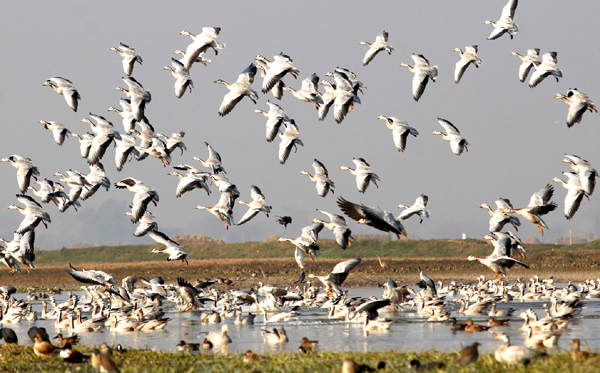The renowned Gharana Wetland has commenced its reclamation of former grandeur by the Wildlife Department. This reinvigoration is chiefly attributed to the amelioration of water quality and a marked proliferation of invertebrates, auguring a substantial surge in the arrival of migratory avian species in the impending winter season. Nestled proximate to the International Border adjacent to Pakistan in R S Pura tehsil, the Gharana Wetland has been steadily diminishing in stature over the years, primarily due to multifarious causes, notably the unbridled inflow of untreated sewage emanating from proximate residences, exacerbated by the lamentable lack of concerted efforts from pertinent authorities to safeguard its ecological integrity.
Every living entity fulfils a pivotal role in the existence of others, a principle decreed by nature itself. When humans transgress this principle, the consequences over time are nothing short of catastrophic. Among all these, bodies of water hold the utmost importance. Not only do they replenish groundwater reserves, but they also serve as vital habitats for numerous bird species and aquatic animals, upon which their entire life cycles hinge. One such disregarded aquatic sanctuary is the Gharana Wetland, situated near R.S. Pura. This heaven for avian species, particularly migratory birds, had been encroached upon, sullied by the discharge of wastewater and sewage from nearby localities. The Gharana Wetland Conservation Reserve, which harbours over 170 species of birds, was perilously close to extinction due to persistent human encroachment. What was once a paradise for both birds and bird enthusiasts has metamorphosed into an almost nonexistent marshland, bereft of essential facilities, lacking proper access roads, and actively discouraged by the local populace. While this detrimental trend persisted over several decades, the authorities entrusted with the care and safeguarding of this wetland appeared to turn a blind eye to the rampant degradation it suffered.
Thanks to the intervention of nature enthusiasts who filed a Public Interest Litigation (PIL) that the High Court took serious cognizance of the degradation of the Gharana Wetland, issuing directives for its protection and restoration. The authorities have since sprung into action, with the Wildlife Department acquiring around 400 kanals of surrounding land. A comprehensive demarcation featuring geological markers and embankments has been implemented, along with measures to prevent the ingress of drainage and sewage water. Subsequently, water quality and the overall expanse of the aquatic habitat have witnessed improvement since the implementation of conservation initiatives. The net result has been heartening, as the population of migratory birds has experienced a substantial resurgence. A blueprint has been drafted to re-establish this wetland with bird-viewing platforms, a biogas plant, a composting facility, wallowing areas, a sewage treatment plant (STP), perching sites, reed plantation areas, and an array of other common amenities, ultimately developing it into a ‘Gharana Eco-Spot.’
With these collective efforts, the Gharana Wetland is poised to become a transformative asset for not only birds but for the local community as well. Once it is adequately developed, this wetland will serve as a tourist magnet, offering economic opportunities for the local population. The entire region can become a tourist circuit, encompassing attractions such as the nearby Suchetgarh village, Bagh-i-Bhour, and the Gharana Wetland. The authorities engaged in this project deserve commendation. Given the dire need to restore, develop, and conserve such natural sanctuaries in the Jammu region, this development project should undoubtedly be accorded the highest priority.
Trending Now
E-Paper


